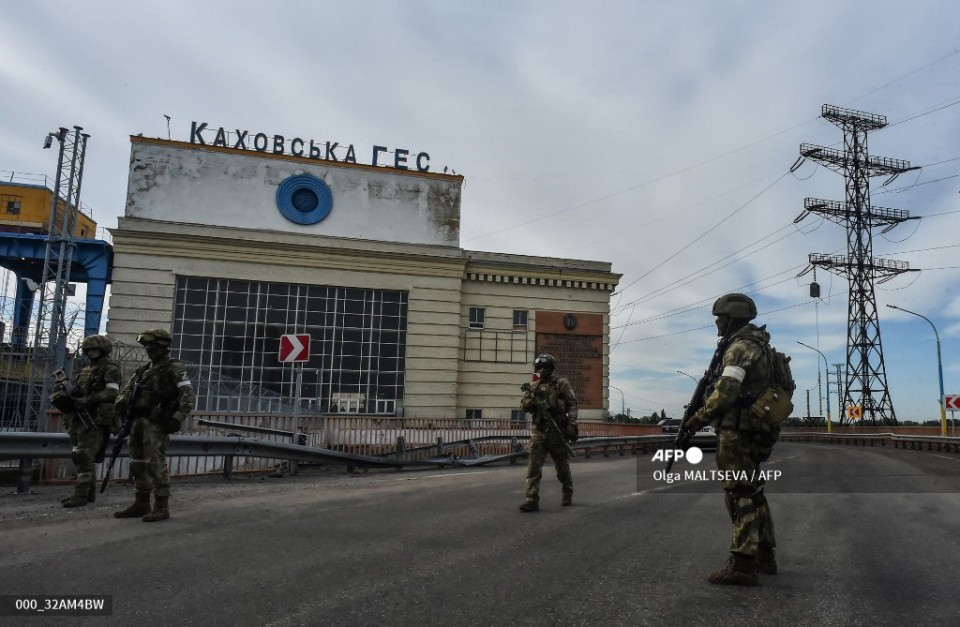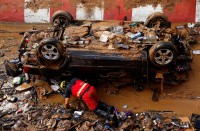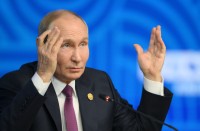
Kyiv, Ukraine | AFP |
by Emmanuel PEUCHOT
Kyiv accused Russia of planning to destroy a hydroelectric dam in the eastern Kherson region, where Ukrainian soldiers have been steadily advancing and Moscow-installed authorities have begun evacuations.
Ukrainian President Volodymyr Zelensky said Russian forces had mined the Kakhovka hydroelectric power plant with the intent of blowing it up, in what would amount to a “catastrophe on a grand scale”.
Hundreds of thousands of people around the lower Dnipro River would be in danger of rapid flooding if the dam was destroyed, Zelensky warned in a speech Thursday to European leaders.
He said cutting water supplies to the south could also impact the cooling systems of the Zaporizhzhia nuclear power plant, Europe’s largest.
And the North Crimean canal, which provides a crucial water supply to Crimea — occupied since 2014 by Russia — could be destroyed.
Russia’s goal is to halt the Ukrainian advance in the region and protect Russian troops, according to Zelensky’s adviser, Mykhailo Podolyak.
– Energy battlefield-
Cities across Ukraine began curbing electricity consumption ahead of winter Thursday as authorities warned that heavy damage to the country’s energy grid by Russian attacks would spark a new wave of refugees from the country.
“Russia’s leadership has given the order to turn the energy system itself into a battlefield. The consequences of this are very dangerous, again for all of us in Europe,” Zelensky said in an address to the EU council
Energy-saving measures were put in place across the country after Russian missile and drone strikes destroyed at least 30 percent of the country’s power stations in a week, according to authorities.
Following blackouts in parts of Kyiv overnight, the city’s mayor Vitali Klitschko urged businesses to limit screens and signage lights “as much as possible”.
“Even small savings and a reduction in electricity consumption in every home will help stabilise the operation of the national energy system,” he said.
Ukrainians responded defiantly.
“It’s not going to change our attitude, maybe we will only hate them more,” said Olga, a resident of Dnipro in central Ukraine who declined to give her last name.
“I would rather sit in the cold with no water and electricity than be in Russia,” she said.
People were rushing to buy auxiliary power supplies like generators and batteries, according to Kyrylo, an electronics vendor.
Speaking of the coming winter, he said: “I think that there will be nothing that we cannot survive.”
“There will be some kind of heating in any case, and the fact that it will be 16 (degrees Celsius, or 61 Fahrenheit) instead of 20 doesn’t matter much. Just put on a thermal and socks,” he said.
– Iranians on the ground –
The White House meanwhile said it had evidence of Iranians taking a direct role in the war, helping Russians direct their Iranian-made “kamikaze drones” — which are destroyed in attacks on Ukrainian targets such as power stations.
“Tehran is now directly engaged on the ground, and through the provision of weapons that are impacting civilians and civilian infrastructure in Ukraine,” said White House national security spokesman John Kirby.
He added that there was also concern Iran might supply surface-to-surface missiles to Russia for use in the war.
“The United States is going to pursue all means to expose, deter and confront Iran’s provision of these munitions against the Ukrainian people,” he added.
The European Union and United Kingdom announced sanctions on three Iranian generals and an arms firm accused of supplying Russia with drones.
However, bipartisan support for military aid to Ukraine is starting to wane in Washington, with Republicans signalling that funding could be cut after congressional midterm elections next month.
“They said that if they win they’re not likely to fund, to continue to fund Ukraine,” US President Joe Biden said while campaigning in Pennsylvania.
“They have no sense of American foreign policy.”
– Kherson evacuation-
Little changed along the long front lines, where Russia has been sending many of the 200,000 troops newly called up to the fight.
Russian President Vladimir Putin on Thursday visited a training centre for mobilised troops south-east of Moscow where he embraced soldiers and fired a gun.
Some fighters opened their rucksacks to show him what they had been equipped with, and he asked one about his family, who replied he had a five-year-old daughter.
Putin hugged him and wished him “good luck.”
Meanwhile Russia continued to evacuate people from Kherson city as Ukrainian forces inched closer to the southern hub, in Moscow’s hands since the earliest days of the invasion in February.
Moscow-installed authorities in Kherson said that around 15,000 people have been moved out.
Russia’s Rossiya 24 TV showed images of people waiting to board ferries, unable to use bridges damaged by Ukraine.
Kirill Stremousov, a pro-Russian official, said on Telegram that the evacuations would give Russian forces more room to fight, and said they would not cede the city back to the Ukrainians.
“Remember, nobody is going to give up Kherson,” he said.
But Ukrainians said the exit of civilians from the area was in fact forced deportations to Russia.
The US-based Institute for the Study of War, in its daily analysis, said that as Ukrainian forces continue to close in on Kherson city, Russian authorities “are likely setting information conditions to justify planned Russian retreats and significant territorial losses.”
© Agence France-Presse








